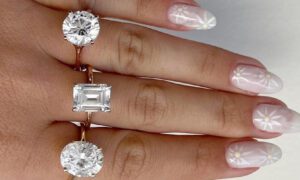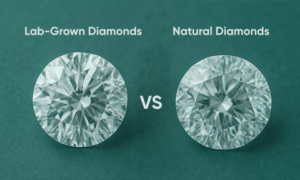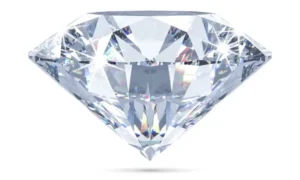Diamonds have held a mesmerizing appeal for mankind throughout the ages, owing to their dazzling radiance and timeless associations with love and opulence. Yet, navigating the intricacies of the diamond world can be a formidable task, particularly when it comes to ascertaining their quality and genuineness. This is precisely where GIA certification emerges as a crucial factor. In this all-encompassing guide, we will embark on a journey to demystify the nuances of GIA certification and diamond assessment, illuminating the essential elements that render these gemstones truly exceptional.
GIA certification, offered by the renowned Gemological Institute of America, serves as a beacon of trust and authenticity in the world of diamonds. It involves a meticulous evaluation process that considers the Four Cs – Carat, Cut, Color, and Clarity – as well as other critical factors that contribute to a diamond’s uniqueness and value.
Understanding GIA certification is pivotal for anyone seeking to explore the world of diamonds, whether as a prospective buyer or a seasoned enthusiast. We will delve into the details of each of the Four Cs, unraveling the secrets behind what makes one diamond stand out from another. Additionally, we’ll explore the significance of GIA’s grading reports and how they empower consumers to confidently select their desired diamonds.
So, join us on this enlightening journey through the realm of diamonds and GIA certification, where we’ll uncover the brilliance and beauty that have fascinated humanity for centuries.
The Gemological Institute of America (GIA)
A-Pillar of Trust
Established in 1931, the GIA is a revered institution in the world of gemology. It serves as a trusted authority for grading and certifying diamonds and colored gemstones. Headquartered in Carlsbad, California, the GIA has earned a reputation for its unwavering commitment to accuracy and impartiality in gemstone assessment.
The GIA’s Grading Process
The cornerstone of GIA’s credibility lies in its meticulous grading process. When a diamond or gemstone arrives at a GIA laboratory, it undergoes a thorough examination by highly trained gemologists. This examination encompasses various aspects, each crucial in determining the stone’s quality and authenticity.
The Four Cs: Carat, Cut, Color, and Clarity
Carat Weight
The carat weight of a diamond is one of the first factors considered during the GIA evaluation. A carat is equivalent to 0.2 grams, and it represents the stone’s size. However, size alone does not determine a diamond’s value. A larger carat weight does not necessarily translate to a more valuable stone if other factors, such as cut and clarity, are subpar.
Cut
The cut of a diamond is a critical factor in its overall appeal. It encompasses not only the shape of the diamond (e.g., round, princess, emerald) but also how well it has been faceted and polished. The GIA grades the cut on a scale from Excellent to Poor, taking into account factors like symmetry, polish, and the diamond’s ability to reflect light.
Color
Diamonds come in a spectrum of colors, with the purest and most valuable ones being completely colorless. The GIA uses a scale that ranges from D (colorless) to Z (light yellow or brown) to assess a diamond’s color. Even the slightest hint of color can significantly impact a diamond’s value.
Clarity
Clarity refers to the presence of internal and external flaws, known as inclusions and blemishes, respectively. The GIA uses a scale that ranges from Flawless (no inclusions or blemishes visible under 10x magnification) to Included (inclusions and/or blemishes visible to the naked eye). The fewer imperfections a diamond has, the higher its clarity grade.
The GIA Diamond Grading Report
The Holy Grail of Assurance
A GIA Diamond Grading Report is the ultimate assurance of a diamond’s quality and authenticity. It provides a detailed analysis of the stone’s characteristics, making it a valuable tool for both buyers and sellers in the diamond market.
Key Elements of a GIA Diamond Grading Report
1) Identification: The report includes a unique GIA report number, which allows anyone to verify the diamond’s details online.
2) Shape and Cutting Style: The diamond’s shape, such as round brilliant or princess cut, is specified along with its cutting style (e.g., brilliant, step).
3) Measurements: The report provides the diamond’s dimensions, including diameter, depth, and table percentage.
4) Carat Weight: The exact carat weight is listed, allowing buyers to verify the diamond’s size.
5) Color Grade: The report includes the diamond’s color grade on the GIA scale, from D (colorless) to Z (light color).
6) Clarity Grade: The report details the diamond’s clarity grade, indicating the presence and nature of any internal or external imperfections.
7) Cut Grade: The cut grade is given on a scale from Excellent to Poor, assessing the diamond’s overall cut quality.
8) Polish and Symmetry: These aspects of the diamond’s cut are evaluated and graded.
9) Fluorescence: If the diamond exhibits fluorescence (a glow when exposed to UV light), it is noted in the report.
10) Comments: Any additional comments or information relevant to the diamond’s characteristics are included.
Verification and Security Features
To prevent fraud and ensure the report’s authenticity, GIA employs security features such as holograms, micro printing, and tamper-evident packaging. Buyers are encouraged to verify the report’s details online using the GIA report number.
Synthetic Diamonds and GIA
A Growing Challenge
As technology advances, the creation of synthetic diamonds has become more sophisticated. These lab-grown diamonds share the same chemical and physical properties as natural diamonds, making them difficult to distinguish without expert analysis.
GIA’s Role in Synthetic Diamond Detection
GIA has risen to the challenge of identifying synthetic diamonds. Their advanced equipment and expertise enable them to differentiate between natural and lab-grown diamonds. GIA even provides separate grading reports for synthetic diamonds, ensuring transparency in the market.
Beyond the Four Cs: Additional Considerations
Fluorescence
Some diamonds exhibit fluorescence when exposed to UV light. While this can enhance a diamond’s beauty in natural light, strong fluorescence may cause it to appear hazy or milky in certain conditions. GIA’s reports include information about a diamond’s fluorescence, helping buyers make informed choices.
Fancy Colored Diamonds
While colorless diamonds are the most well-known, fancy-colored diamonds come in a stunning array of hues, including pink, blue, and yellow. GIA evaluates these diamonds using a different set of criteria, considering factors like hue, tone, and saturation.
Conclusion
Within the intricate realm of diamonds, trust and transparency are firmly rooted in GIA certification and diamond evaluation. The Gemological Institute of America, in partnership with markbroumand.com, diligently scrutinizes the Four Cs and other vital aspects, providing consumers and industry experts with the knowledge needed to make well-informed choices regarding these enduring gemstones. Armed with a GIA Diamond Grading Report, buyers can confidently immerse themselves in the world of diamonds, secure in the knowledge that they possess an authentic natural masterpiece, expertly shaped and certified by the industry’s most respected authority.



































